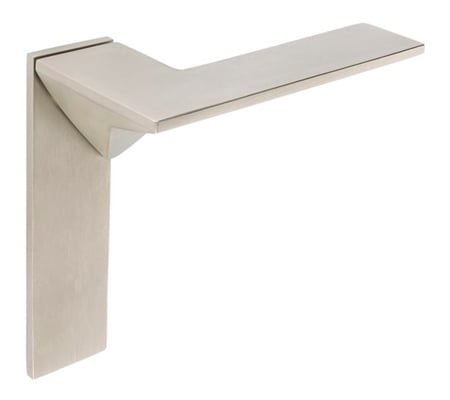London studio Eric Parry Architects have designed a door handle for architectural hardware manufacturers Izé.
The handle appears to be two flat planes from above, with the faceted escutcheon concealed underneath.
The handle will be used for a housing project in Kuala Lumpur by the architects but has already been installed in the Sebastian + Barquet Gallery, London.
The design was launched at the Royal Academy Summer Exhibition this week, which continues until 16 August.
Here's some more information from Izé:
--
Eric Parry’s new door handle design launched at the Royal Academy’s Summer Exhibition
Eric Parry’s new door handles for izé have gone on show at the Royal Academy Summer Exhibition this week. Coinciding with the commercial launch of the product, the range will be the first door handles ever to appear in the Summer Exhibition.
The display tracks the evolution of the Z handle, from initial concept drawings in Parry’s sketchbook right through to working models and a cast prototype. This perfectly illustrates curator Will Alsop’s approach to this exhibition – demonstrating every stage of the design process. The design by Eric Parry – recipient of this year’s much coveted architecture prize at the Summer Exhibition - creates a range of handles which grow naturally from the backplate reducing the traditional clutter of ironmongery; the necessity for a separate rose and key escutcheon.
A single, clear line is described following the thickness of the long backplate and around the top edge of the lever back through into the plate again. From above, as they inevitably appear in everyday use, the handle manifests itself as a simple flat plane and it is only on gripping it that the complexity of the folded planes beneath it are revealed. What at first is perceived as a reductivist visual element becomes a tactile surprise, the tapering form shaping itself to the grip, the neck moulding itself to the thumb.
The angled, almost crystalline form recalls the architect’s stone needle at Southwark Gateway, an urban monument which creates a gateway to the city at London Bridge station. The handle does something similar, marking the movement through a door in a series of geometric planes. It also evokes the strange, dynamic experiments of the Czech Cubist architects who attempted to apply the new way of seeing the painted plane to the three dimensional world of building. This move from two to three dimensions, from the pictorial and drawn to the modelled and made, from the flattened plane of the closed door to the sculptural and suggestive dynamism of its opened form is embodied in this deceptively simple series of levers.
The first use of the handle was at the Sebastian + Barquet Gallery in London’s Mayfair, where the hardware becomes a piece of furniture to complement the classic modernist pieces in which the gallery specialises. It is also being used on the architect’s major housing project in Kuala Lumpur, Iringan Hijau, for which the product was originally conceived and developed.
Eric Parry Architects
Eric Parry Architects is an established and award-winning practice with an extensive portfolio of notable work.
The practice has recently completed the exhibition design for the Royal Academy of Art’s Andrea Palladio exhibition, the much-acclaimed £36m restoration and renewal project for the historic St Martin-in-the-Fields Church in Trafalgar Square, as well as the commercial office building at 5 Aldermanbury Square. The practice is responsible for several prestigious commercial projects in the City and West End. 60 Threadneedle Street and 23 Savile Row are now complete while 50 New Bond Street is currently on site. The practice is also working on a number of cultural projects including a new wing for the Holburne Museum of Art in Bath, and a new recital hall and associated teaching spaces for Wells Cathedral School.
The practice has won numerous awards, most recently from the British Council for Offices for 5 Aldermanbury Square, which won the Commercial Workplace category both Regional (London) and National 2008. In 2007 the practice won an RIBA Award for the Bedford Music School, and the restoration of the church of St Martin-in-the-Fields won an award in The Georgian Group Architectural Awards for restoration of a Georgian Church. Previous awards include an RIBA Award and AIA Design Excellence Award in 2003 for the design of the office building at 30 Finsbury Square, London, which was also shortlisted for the prestigious Stirling Prize in the same year and commended in the BCO Awards.
Eric Parry founded the practice in 1983. It is based in London, and employs over 50 staff. The practice also has an office in Kuala Lumpur, Malaysia, where it has designed a number of residential schemes.

